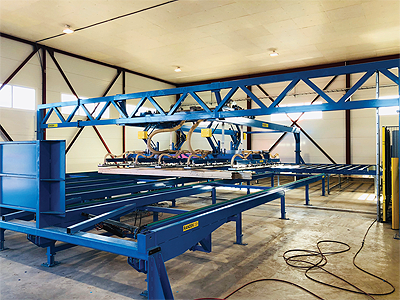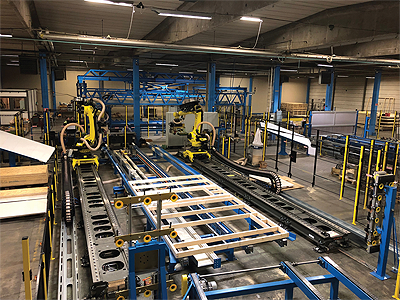Randek
Innovation – a way of life
Randek leads the way in the development of ingenious automatic solutions for prefab home manufacturers, constantly introducing improvements to its systems to address emergent customer demands
A whole lot of ‘firsts’ are associated with Randek, hence the reputation held by the manufacturer of high-performance machines and systems for the prefabricated house manufacturing industry as the most innovative in its sphere. Since the 1960s, the forward-thinking Swedish company’s focus has fallen entirely on the delivery of automation equipment, examples of which  represent some of the fundamental systems used to this day by the prefab home industry.
represent some of the fundamental systems used to this day by the prefab home industry.
“Things like the butterfly table or the nailing bridge are Randek innovations that have been widespread for many decades now,” claims the company’s Chairman, Johan Larsholm. “Over time, we have started to automate more and more, and one of the remarkable milestones we have reached, was the delivery of the very first mass production line to the US – the Auto Wall system, which still has the highest capacity in the market many years after it was released.
“Another historically significant development that we have introduced, was the first-ever CAD/CAM wall production line back in the 1980s. It was key for us to find a way to convert CAD data to production data, in order to manufacture a variety of wall elements more quickly and efficiently, and we are proud that the line is still up and running at the factory of one of our main customers, Myresjöhus,” Johan discusses.
Randek has also made notable strides in the realm of roof trusses. The company delivered the first automatic truss production line, having recently released its AutoEye solution, which enables a photo of the truss to be taken and then compared to a CAD-generated theoretical model. “The system can pick, place, position, and press the nail plates to the roof truss automatically, which means that these processes need no longer be manually done. This, in turn, improves the accuracy and the speed of the plating process immensely,” Johan explains.
“As of late, we have also embraced the opportunity to introduce robotics to our offering, and the ZeroLabor robotic system is a fantastic addition to our product range,” he continues. “The customers are increasingly interested in automation and ZeroLabor, as a fully automatic solution, has a real appeal for them. Its flexibility allows it to be integrated into existing production lines or work as a standalone unit and it can handle the production of walls, floors, and roofs. In fact, I believe this is the only robotic wall production line available in the market at the moment.”
In recognition of the growing demand for robotic solutions, Randek has initiated a series of development projects that will enable the utilisation of robots in some of the more traditional systems created by the company. “A recent novelty is the introduction of a third robot to ZeroLabor to increase the capacity of the product and give customers more options when choosing the level of capacity that they need,” Johan says. “We have also developed an add-on function to the ZeroLabor system where the robots also cut, place and fasten laths automatically. These are important pieces that create a ventilated cavity between the wooden cladding and the external sheet. All in all, we are constantly trying to equip our existing systems with useful new features and strongly invest in this kind of project.”
When asked about the secret behind the efficiency of Randek’s operations, Johan maintains that the key is to set up the right capabilities within the company and have them interact as smoothly as possible. “For example, we have an in-house mechanical design team, as well as a dedicated software team to develop the software code to the machines and the robots. Furthermore, the resources at our disposal also include a CDT-file system to translate production data, and a 3D model converter software.
“The overarching element, however, is the skilful staff that can build these mechanical systems and that possess the required know-how about commissioning, setting up the factories, and getting them up and running through connecting all the data. In many instances, we start from scratch and end up delivering a holistic solution, and for us to be able to do that, we need all the preconditions to be fulfilled,” Johan adds.
“Taking into account the ongoing trends in customer preferences, we feel that we are well-positioned to meet their needs,” he turns his attention to what the future may hold in store for the company. “The prefabricated home manufacturing sector is very buoyant and as demands for prefabrication grows, so does demand for automation equipment. For example, Australia’s biggest house dealer is currently setting up the biggest house factory in the world and we are supplying them with two AutoEye systems and four Auto Wall lines.
“At the same time, it is not just big factories and big wall production lines that are required from clients. A lot of customers want smaller and more compact lines and we have recently delivered a successful project in North America where we installed two ZeroLabor units with just one robotic cell and one framing station. This trend is also the cue for us that we can more actively target smaller and mid-sized companies who may not have the space to accommodate extremely long production lines,” Johan observes.
He has also noticed that customers are often keen on having the opportunity to upgrade their Randek equipment later on, once they have purchased one or more pieces at first. “Many people will share with us that, for example, they do not insulate a wall in-house, but are planning to start doing so at some point in the future, so they are interested in the possibility of slightly reconfiguring their production lines, and this is just what we offer. They do not have to invest in entirely new equipment, but only add one or two more machines to grow the capability they need, and this proposition on our part is another good example of the level of flexibility we display in serving our customers.”
From speaking to Johan, it became crystal clear that innovation is a way of life for Randek. It was also astonishing to discover how many of the most advanced automation systems utilised by the prefab home industry have been borne out of the company’s creative genius and dexterous deployment of technology. With market conditions being favourable and its desire to play around with its systems insatiable, exciting times are ahead for the Swedish manufacturer.
Randek AB
Products: Automation equipment for the prefabrication home market
